Original Newspaper Account Bennington Battle 1777
About Seller
522 South Pineapple Avenue
Sarasota, FL 34236
United States
Sarasota Estate Auction specializes in a wide variety of furniture, antiques, fine art, lighting, sculptures, and collectibles. Andrew Ford, owner and operator of the company, has a passion for finding the best pieces of art and antiques and sharing those finds with the Gulf Coast of Florida.
Two ways to bid:
- Leave a max absentee bid and the platform will bid on your behalf up to your maximum bid during the live auction.
- Bid live during the auction and your bids will be submitted real-time to the auctioneer.
Bid Increments
| Price | Bid Increment |
|---|---|
| $0 | $10 |
| $100 | $25 |
| $250 | $50 |
| $1,000 | $100 |
| $2,500 | $250 |
| $7,500 | $500 |
| $20,000 | $1,000 |
| $50,000 | $2,500 |
| $100,000 | $5,000 |
| $250,000 | $10,000 |
About Auction
Aug 5, 2023
Featuring a Lifetime Collection of Early American Pottery, a Fantastic Georg Jensen Sterling Tea Set - 23 OZT, Important Books and Ephemera, and Exquisite Estate Jewelry. Also including art from artists including Roy Lichtenstein, Camille Pissarro, Karel Appel, Victor Vasarely, and many more. Sarasota Estate Auction sarasotaestateauction@gmail.com
- Lot Description
Original Newspaper Account Bennington Battle 1777 This is an original newspaper account of the Battle of Bennington in Vermont which started to turn the tide of the Revolutionary War against the British and in favor of the Americans in 1777. The battle was important because the commander of British forces in the area, General Burgoyne, lost a significant number of his men to the Americans and that set the stage for him to lose to the Americans at Saratoga Springs two months later, which was one of the pivotal battles of the Revolutionary War. The newspaper has four pages and the masthead reads “Vol. X [Numb. 476] Independent Chronicle And The Universal Advertiser, Thursday, August 21, 1777, Massachusetts-State, Boston: Printed by Powars and Willis, Opposite the New Court-House.” The ornament on the masthead shows a soldier standing with a drawn sword and a banner reading “Appeal to Heaven” and “Independence." “W J Chandler” is inscribed at the upper left corner of the front page and the article is in the first and second columns of the third page. The Independent Chronicle was a Boston newspaper that originated in 1768 as the Essex Gazette and the New-England Gazette, before it became the Independent Chronicle in 1776, so essentially it was a Revolutionary War era Boston newspaper. The background to the Battle of Bennington reveals the battle plans of the British to advance the war in their favor, and it backfired horribly. In early 1777, British officials considered a number of plans for their upcoming campaign against the Americans, and the one they apparently decided upon was to campaign through the Hudson River Valley and thereby cut off New England from the rest of the colonies. General William Howe was to drive north from New York City while General John Burgoyne was to drive south from Canada, and British General Barry St. Leger would drive down the Mohawk Valley in upstate New York. The major problem was not with the plan, but with its execution. Historians debate whether Howe was ill-informed or simply acted on his own, but he decided instead to capture Philadelphia, the seat of the Continental Congress, rather than to work in concert with Burgoyne and Leger; maybe Howe hoped by seizing Philadelphia, he would rally the Loyalists in Pennsylvania, discourage the rebels by capturing their capital, and bring the war to a speedy end, but it didn’t work out that way. Burgoyne was a top-notch British commander who had sent a detachment of troops to forage in Bennington for much needed supplies. Bennington was a town in southern Vermont and he didn’t expect much opposition, but he didn’t know that American Brigadier General John Stark was nearby, and Stark and the local militia killed or captured nearly 1,000 of Burgoyne's 7,000 invading troops, which slowed down his invasion plans for New York. The British general was supposed to march down the Hudson River Valley and meet up with Howe in New York, but Howe had turned his attention to Philadelphia, and losing 1000 men at Bennington was costly to Burgoyne - it deprived him of troops he needed to beat the Americans at Saratoga Springs, and that was a big turning point in the war: these American victories were critical because they revitalized American hopes for achieving independence and played a key role in bringing France into the war on the rebel side. So, the victory at Bennington was very important to the course of the war, and some of these details are laid out here in the newspaper account of the event. The battle took place on August 16, 1777, five days before the newspaper account was published, and Stark’s rebel force of 2000 men, made up of New Hampshire and Massachusetts militia reinforced by Vermont militiamen and the Green Mountain Boys, showed how working together could defeat a larger force that was uncoordinated and not sticking to plan, and the battle's anniversary is celebrated in the state of Vermont as Bennington Battle Day. The newspaper measures 15 1/4 x 19 1/2 in. wide when unfolded, with light wear at the edges, light browning, a few small holes, a tear on the horizontal seam and four thin vertical tears about two inches long apiece, but a rare and important piece of American history. #83, #1607
- Shipping Info
-
SHIPPING INFORMATION·
Sarasota Estate Auction IS NOT RESPONSIBLE FOR SHIPPING. All shipping will be handled by the winning bidder. Sarasota Estate Auction recommends obtaining shipping quotes before bidding on any items in our auctions. If you are interested in obtaining any information on local shippers, please send us an email and we will kindly send you a list of local shippers. Refunds are not offered under any circumstances base on shipping issues, this is up to the buyer to arrange this beforehand.
Premier Shipping, info@premiershipment.com
-
- Payment & Auction Policies
-
Available payment options
We accept all major credit cards, wire transfers, money orders, checks and PayPal. Please give us a call at (941) 359-8700 or email us at SarasotaEstateAuction@gmail.com to take care of your payments.
-
- Buyer's Premium



 EUR
EUR CAD
CAD AUD
AUD GBP
GBP MXN
MXN HKD
HKD CNY
CNY MYR
MYR SEK
SEK SGD
SGD CHF
CHF THB
THB



























